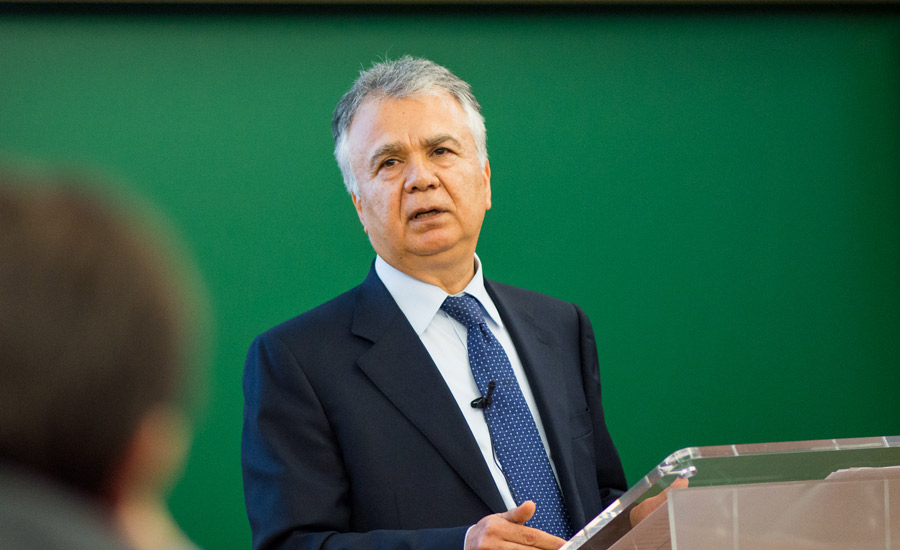
“Everything changes when you adopt a different approach.”
Yossi Hollander, founder of Fuel Freedom Foundation, called for new solutions to tackle energy poverty at IESE in Barcelona this week.
Presenting the Fuel Freedom Chair on Energy and Social Development together with Chair holder, Prof. Ahmed Rahnema, Hollander advocated adopting an innovative, multi-layered perspective to alleviate energy poverty, focusing on Africa.
Why Africa?
In terms of energy poverty, Sub-Saharan Africa is “the worst in the world” said Rahnema.
Some 600 million people in this region do not have steady and affordable access to electricity. They do not have a reliable source of energy to sustain homes, schools or hospitals, he said.
A further problem is the financial burden facing most oil-dependent African countries. Oil represents a significant trade deficit in the majority of African countries, said Hollander. “Most Sub-Saharan African countries’ total exports are significantly smaller than their oil imports. How can they drive development on this basis?”
The energy issue, said Rahnema, is a “powerful bottleneck” that threatens to hamper Sub-Saharan Africa’s potential growth and prevent it catching up with the rest of the world.
So Where Are the Opportunities?
“The Fuel Freedom Chair on Energy and Social Development will aim to drive a deep understanding of market dysfunction and inefficiencies,” said Rahnema, “and how they generate entrepreneurial opportunities as people look for solutions.”
In particular, research will focus on key energy–related areas: transportation, cooking, fertilizers and electricity.
“There are a lot of problems that don’t typically register at all in other regions,” said Hollander.
One example is the cost and use of energy in preparing food.
This can range from 10 to 40 percent of average daily income. Meanwhile the wide-spread use of biomass fuel in cooking has demonstrable links to a range of respiratory diseases.
And the issue is further complicated by basic priorities.
“While bringing a reliable supply of power to African households is a key issue in Sub-Saharan development, the daily need to cook – in other words, to eat – is a much more pressing priority for families,” said Hollander.
Analysis of these challenges, or market dysfunctionalities, will shed light on the kinds of entrepreneurial opportunities they also yield, said Rahnema.
Although this is contingent on a deep understanding of local market dynamics and other challenges.
“You can have a practical impact by listening to the local people. And by understanding how local business dynamics operate to come up with viable alternative strategies.”
Funding and investment too, he cautioned, are prone to obstacles such as inadequate legal frameworks, infrastructure issues, corruption and “a constant changing of the rules.”
Seeing the Challenges and Solutions Through a Wider Lens
In this challenging context, Rahnema and Hollander outlined four key success factors in driving solutions to energy poverty in developing markets:
• Flexible thinking. Working with emerging markets is contingent on adjusting our “model,” says Hollander. “People there live in a different society – we need to move along with it.” There are already innovative solutions for electricity: “cleaner, cheaper, safer sources. It all exists – you just don’t see it.” As an example he cited importing cheap ethanol from countries that have a surplus, such as Qatar. Rahnema cited the discovery in Kenya that the main reason ethanol was not being used as a blending alternative to kerosene and diesel was that it was taxed while the others were subsidized; a regulatory, rather than a sourcing, issue.
• Building local partnerships. “History has shown us time and time again. Any attempt to solve energy and infrastructure deficits in Africa coming from outside has failed,” said Hollander. Key to the success of the Chair’s objectives is working with local entities. “One of the first things we did was to consult the regulators,” Rahnema said. “We also mediated with individuals in the local community as well as private institutions, to try and find innovative solutions to key challenges before we get out of here.” An example of success in collaboration with with a core local group comes from Kenya – where the ethanol taxation issue was resolved with input from public and private sector stakeholders.
• Scaling up strategically. To avoid “pilot-itis” Hollander highlighted the importance of selective targeting with a view to scaling up local ideas through private sector investment. “There are a certain number of families and countries in the world that run the country. Success breeds success – it has to come from people with money. It will not come from a small village in Southern Spain or Kenya.” Hollander added that there were opportunities for large and small private sector companies alike.
• Breaking new ground in education. Information gathering on the ground and raising awareness should be priorities. “We can be the guide and build capacity in education,” said Hollander, “although experimenting or forcing the adoption of a Western model can be both expensive and dangerous.” Rahnema pointed to the use of cases in driving foreign investment in education. “Securing this information and transmitting it is one of the key tasks of the chair.”
A Holistic Approach
Dean Jordi Canals applauded the Chair’s work and highlighted its social impact; very linked, he said, to the mission of IESE.
He pointed to the “invaluable multiplying effect” of students, participants and graduates of IESE and its affiliate schools, including those in Africa.
Canals voiced his hope that their contribution would continue to reflect a “holistic” approach to business that goes well beyond “the merely functional.”
A generalist approach to resolving challenges and problems, such as that evidenced by the Chair’s work, said Canals, is “very much at the heart of what this school is trying to do.”